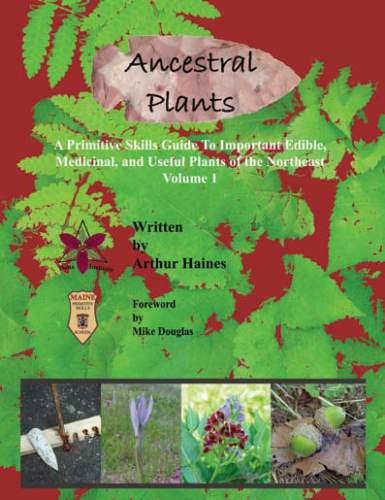by Arthur Haines
Anaskimin, 2010
By the time you read this, the annual banquet of fiddleheads may have passed, but a cornucopia of other wild foods, medicines, and materials are available to anyone who cares to discover them. Arthur Haines can aid this discovery with his excellent new work, Ancestral Plants, a book that will be enjoyed by those looking to find a deeper relationship to the natural world through interaction with the plants that surround us.
Beyond (but including) widely known wild foods such as fiddleheads, wild leeks, and blueberries, Haines opens the door to creating positive, non-exploitive, mutually beneficial relationships with the myriad wild plants that surround us in the northeastern landscape. The guide is easy to use and backed by Haines’s own experiences and research as a practitioner and teacher of foraging skills.
Ancestral Plants offers brief but highly informative accounts of over 100 plant species in the Northeast. Each species account includes scientific and common names, color photos, a quick reference guide to major types of uses, and brief botanical descriptions. The descriptions of uses are succinct but quite thorough and truly useful. Haines has organized information about harvest timing, standard dosages, modes of medicinal action, routes of administration, and phytochemical classification in separate sections that work in concert with the individual species accounts to convey the full detail and understanding necessary to make use of each plant. As indicated by the subtitle, Ancestral Plants goes beyond edible and medicinal uses to explore the many ways plants can meet our material needs, from fire making to cordage, basketry materials to primitive archery supplies. Haines’s “primitive skills” approach applies to his presentation of edible and medicinal plants as well: he favors simple preparations and processing methods that require little or no specialized modern equipment.
As might be expected from a botanist like Haines (and as is needed for a truly accurate plant reference), scientific names are predominant in the text, but readers whose Latin is a bit rusty need not fear, as common names are provided as well. Plant descriptions, however, are left intentionally brief with the expectation that users will accompany this volume with one of the many existing plant identification guides. (Haines’s other works, including the Flora of Maine, are among the more technical guides on the market.)
The “Volume 1” in the subtitle leaves me hoping that it will not be too long before we can enjoy more in this vein from the author. Note that Ancestral Plants is self-published and not currently available through large distributors but can be ordered from the author here.


